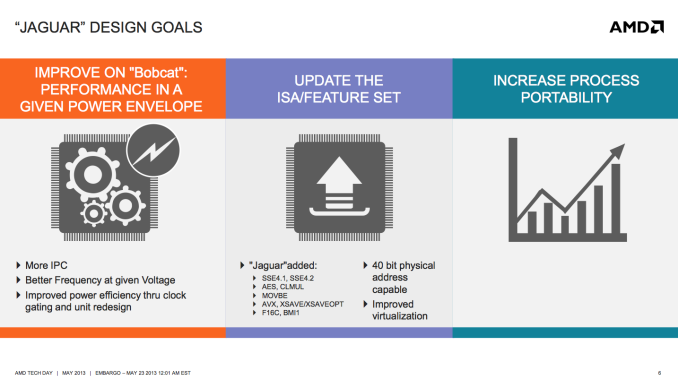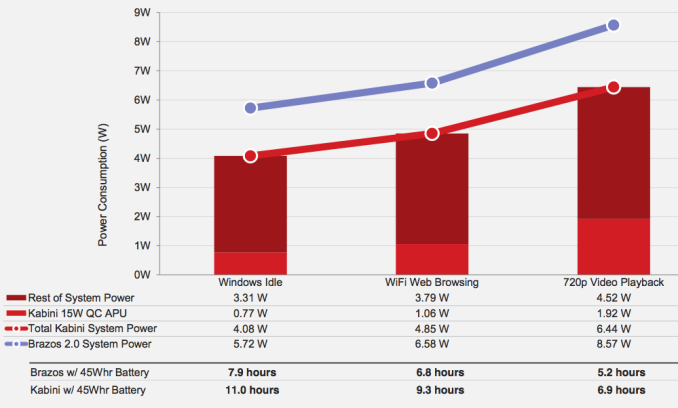AMD’s Jaguar Architecture: The CPU Powering Xbox One, PlayStation 4, Kabini & Temash
by Anand Lal Shimpi on May 23, 2013 12:00 AM ESTFinal Words
Bobcat was a turning point for AMD. The easily synthesized, low cost CPU design was found in the nearly 50 million Brazos systems AMD sold since its introduction. Jaguar improves upon Bobcat in a major way. The move to 28nm helps drive power even lower, which will finally get AMD into tablet designs with Temash. Despite being lower power, Jaguar also manages to increase performance appreciably over Bobcat. AMD claims up to a 22% increase in IPC compared to Bobcat. Combine the IPC gains with a more multi-core friendly design and Jaguar based APUs should be appreciably faster than their predecessors.
Quite possibly one of the only real weaknesses with Jaguar is the lack of aggressive turbo modes in any of the shipping implementations of the design. It appears that the first implementations of Jaguar were under time constraints, leaving many features (including improved thermal monitoring/management and turbo boost) on the cutting room floor. Kabini and Temash seem ripe for a mid-cycle update enabling turbo across more parts, which could do wonders for single threaded performance.
The Jaguar power story actually looks very good, it's just hampered by traditional PC legacy. None of the launch APUs here support the low power IOs necessary to drive platform power down even further. AMD is getting very close though. Jaguar's core power is easily sub-2W for lightweight tablet tasks, the rest of the platform (excluding display) drives it up to 4 - 7W. AMD definitely has the right building blocks to go after truly low power tablets in a major way, should it have the resources and bandwidth to do so.
In its cost and power band, Jaguar is presently without competition. Intel’s current 32nm Saltwell Atom core is outdated, and nothing from ARM is quick enough. It’s no wonder that both Microsoft and Sony elected to use Jaguar as the base for their next-generation console SoCs, there simply isn’t a better option today. As Intel transitions to its 22nm Silvermont architecture however Jaguar will finally get some competition. For the next few months though, AMD will enjoy a position it hasn’t had in years: a CPU performance advantage.
I can’t stress enough how important it is that AMD continues to focus on driving the single threaded performance of its cat-line of cores. Second chances are rare in this business, but that’s exactly what AMD has been offered with the rise of good enough computing. Jaguar vs. Atom is the best CPU story AMD has had in years. Regular updates to the architecture coupled with solid execution are necessary to ensure that history doesn’t repeat itself in a new segment of AMD’s business.
Long term, I can’t help but wonder what Bobcat’s success will do to shape AMD’s future microarchitecture decisions. I’m not sure what Jim Keller’s SoC project is, but I’m wondering if the days of really big cores might be over. I don’t know that really small cores are the answer either, but perhaps something in between...












78 Comments
View All Comments
blacks329 - Thursday, May 23, 2013 - link
I know its definitely not that high for any individual platform, but I do remember a lot of major publishers, Ubi, EA and a bunch of other smaller studios had said (early-mid gen) that because porting to PS3 was such a nightmare and resource intensive, that it was more efficient to spend extra resources initially and use the PS3 as the lead and then have it ported over to 360, which was significantly easier.While I'm sure quite a large chunk still use 360's as their lead platform, I would say 90% was probably very early in this gen and since then has dropped to be much closer between 360 and PS3.
Although at this point both architectures are well understood and accounted for that most engines should make it easier to develop for both regardless of what platform is started with.
mr_tawan - Sunday, May 26, 2013 - link
I don't think using x86 would benefit the dev as much as many expected. Sure using the same hw-level arch may simplify the low-level code like asm, but seriously, I don't many of devs nowaday uses asm intensively anymore. (I had been working for current-gen console titles for a little, and never write even a single line of asm). Current-gen of game is complex, and need the best software architecture, otherwise it would lead to delay-to-death shipping schedule. Using asm would lead to premature optimisation that gains little-to-nothing.What would really affect the dev heavily is sdk. XB1 uses custom OS, but the SDK should be closed to Windows' DirectX (just like XB360). PS4, if it's in the same fashion as PS3, would use the custom-made SDK with OpenGL/OpenGL ES API (PS3 uses OpenGL ES, if I'm not mistaken). It needs another layer of abstration to make it easier to make it fully cross-platform, just like the current generation.
The thing that might be shared across two platform might be the shader code, if AMD can convince both MS and Sony to use the same language.
That's only guesses, I might be wrong.
mganai - Thursday, May 23, 2013 - link
That, and Intel's been making a bigger push for the smartphone market; it even says so in the article!Silvermont should change things up quite favorably.
mschira - Thursday, May 23, 2013 - link
Well all this is pointless if nobody makes good hardware using it.It's the old story. The last generation Trinity would have allowed very decent mid range notebooks with very long battery run time and more than sufficient power at reasonably low costs.
Have we seen anything?
Nope.
So where is a nice 11" Trinity Laptop?
Or a 10" Brazos?
All either horrible cheap Atom or expensive ULV core anything.
Are the hardware makers afraid that AMD can deliver enough chips?
Are they worried stepping on Intels toes?
Are they simply uncreative all running in the same direction some stupid mainstream guide tell them?
I suspect it is largely the latter - and most current notebooks are simply uncreative. The loss of sales comes to no surprise I think. And its not all M$ fault.
M.
Mathos - Thursday, May 23, 2013 - link
It could be another instance of Intel paying oems to not use certain AMD parts. They've done it before, wouldn't be surprised if it happens again in area's where AMD might have a better component.But it's also not totally true, having worked at Wal-Mart and other big chain stores, I can tell you that many do carry laptops and ultrathins that use Trinity A series chips, and Brazos E series chips. But, right now, everyone still wants that ipad or galaxy tab. And in general the only people I saw buying laptops and ultrathins were the people during the back to school or back to college crowds. And of course black Friday hordes.
And with AMD having both next gen consoles under their belt, them and many OEMs may be able to leverage that to draw sales of jaguar based systems.
Gest - Saturday, May 25, 2013 - link
So does Jaguar have new (any) hardware instructions that intel processors don't? (Will intel add them in haswell?) I think game makers will use them actively during the consoles lifetime.scaramoosh - Monday, May 27, 2013 - link
Doesn't this just mean the console CPU power is lacking compared to what PCs currently have?Silma - Wednesday, May 29, 2013 - link
Absolutely.